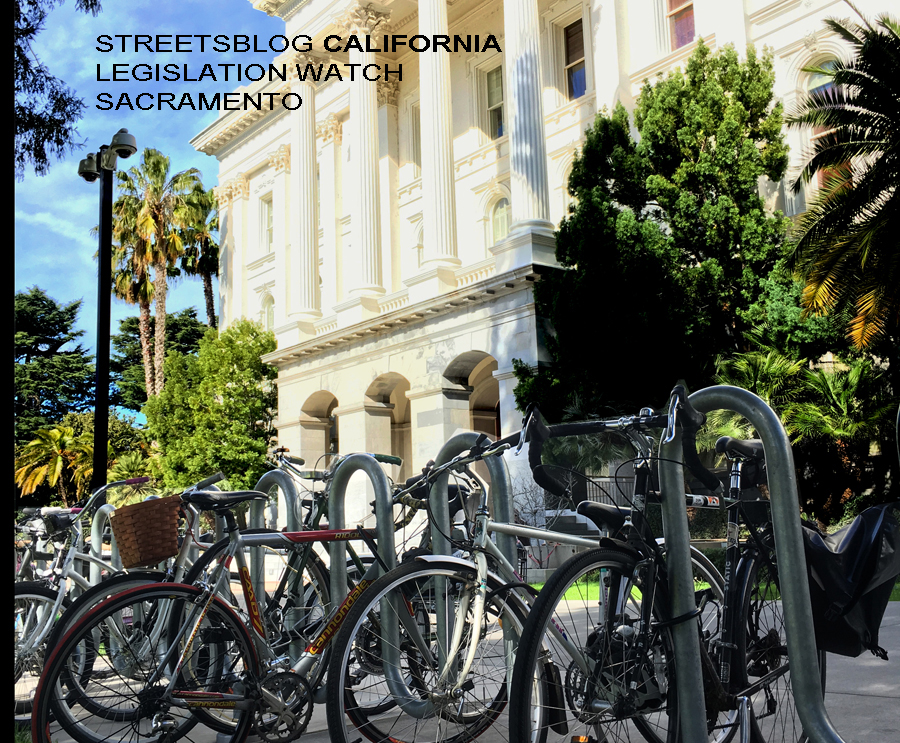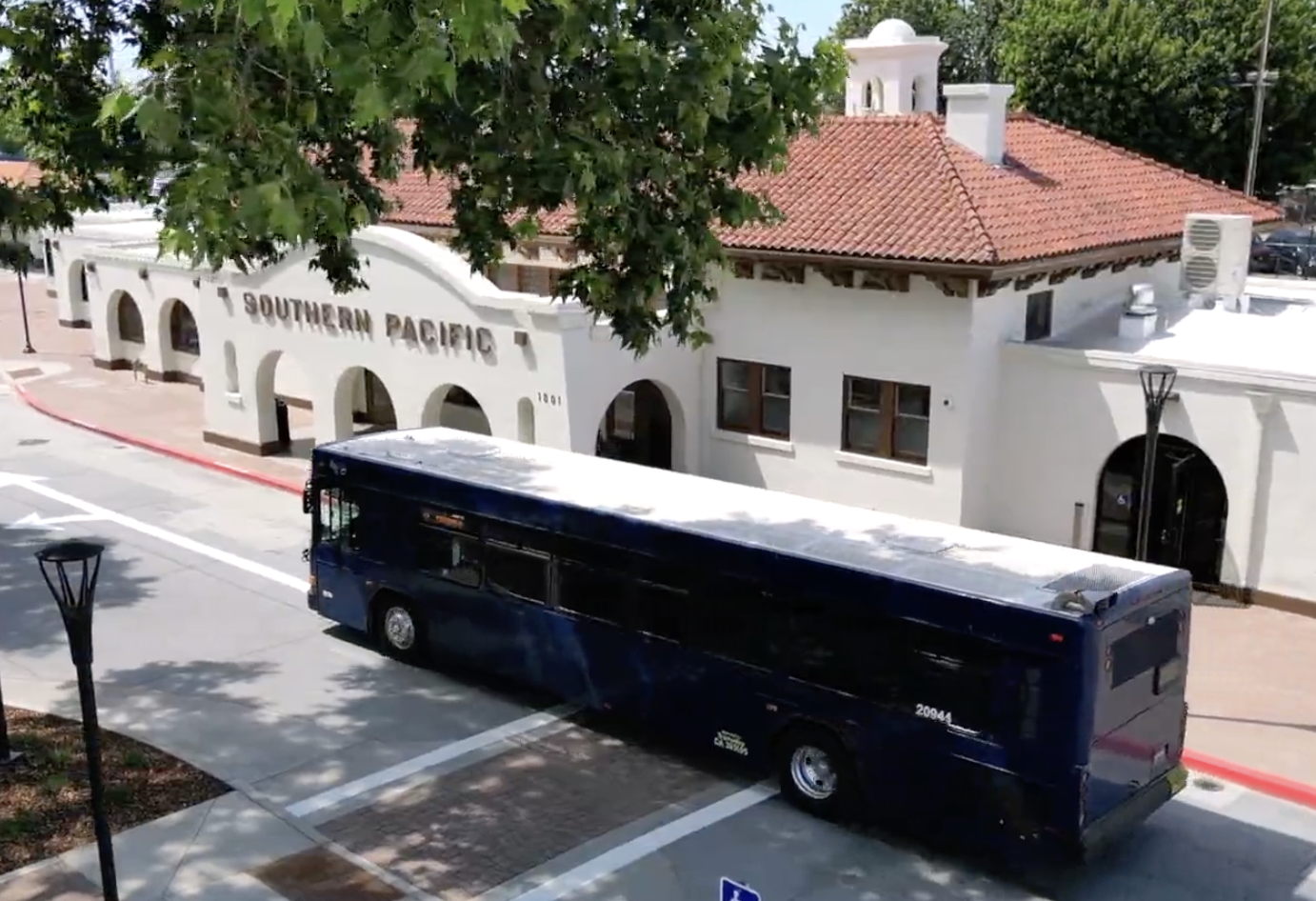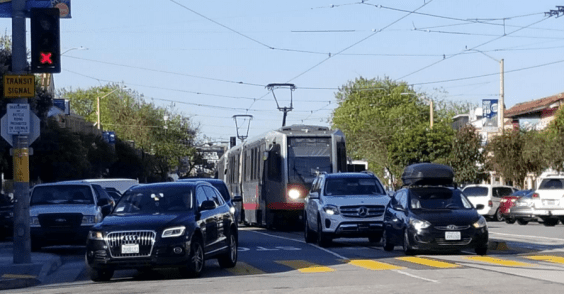Cap-and-Trade Funding Will Go For Electric Vehicles, Other Programs–But Not Transit Passes
5:29 PM PDT on September 19, 2017

A lot happened in the last few days of the California legislative session. Before hitting the deadline to pass bills for the current session—a deadline that was extended beyond midnight Friday—the legislature engaged in a lot of last-minute negotiations that led to nail-biting moments as vote rolls were held open while legislators were cajoled, bullied, or otherwise convinced them get on board.
Nearly lost in all the shuffle were two bills that divvy up money from the state's cap-and-trade system. Governor Brown signed them as soon as they reached his desk on Saturday morning.
A.B. 109 and A.B. 134 are both “budget trailer” bills that nail down budget details that weren't finished before the June deadline. Both deal with proceeds from the Greenhouse Gas Reduction Fund, which receives money from cap-and-trade—and which, with the passing of the reauthorization of cap-and-trade, has been collecting more money than in recent years.
A portion of cap-and-trade funding is already allocated by law annually, to programs that include High-Speed Rail, Affordable Housing and Sustainable Communities, Low Carbon Transit Operations and intercity rail. But the remaining forty percent of the revenue is left to yearly budget negotiations. For 2017-2018, that amounts to almost $1.5 billion, collected over the last few years. That's a lot of money, and how it gets invested is an important indicator of California's priorities as a state.
It's supposed to go to reduce greenhouse gas emissions—but there is no clear consensus on the best way to do that. Or rather, there are so many ways to reduce GHGs, and they all cost so much money, that there's no clear consensus on the most efficient and cost-effective way to invest the money.
In the final days of the session, budget committees in both the Senate and the Assembly held long hearings wherein many worthy causes argued the merits of the case for them receiving money from the program. The governor put out his own list of priorities. Eventually an agreement was hammered out. While there are some good programs in the bill, and there were some annoying omissions.
Included in the bills were:
- $85 m to reduce agricultural sector emissions by providing money to replace off-road equipment and heavy-duty trucks
- $60m for energy efficiency in the food processor industry
- $6m for renewable energy in the agricultural sector
- $99m for dairy digester research and development and management
- $140m for the Freight Equipment Advanced Demonstration and Pilot Commercial Deployment Project
- $180m for Hybrid and Zero-Emission Truck and Bus Voucher Incentive Project
- $100m for Enhanced Fleet Modernization Program and Plus-Up Pilot Project, which provides incentives for low and moderate income electric vehicle buyers, school bus replacements, and rebates for low-income applicants to junk old dirty cars and replace them with cleaners ones
- $26m for urban greening
- $10m for the Transformative Climate Communities program
- $12m for university research on GHG reduction
- $5m for Conservation Corps
- $325m to state and local departments for preventing and fighting wildfires, including forest health and vegetation management projects and biomass energy generation,
- $15m for wetlands restoration
- $20m for wildlife conservation
- $6m for coastal conservation
- $29m for local air quality monitoring in high-priority locations
- $40m for waste management
- $18m for low-income multifamily, solar, and farmworker weatherization programs
It's a mixed bag. Sectors that need money to retrofit and replace old equipment, or figure out new ways of using and producing energy, will get some aid. Natural resources finally got some investment, including $20 million for urban forestry. Chuck Mills of California ReLeaf is pleased with what he calls a “strong allocation to the program” even though it's not as much as they had asked for.
ReLeaf focuses on the connections between urban forests, climate change, and environmental justice issues. Mills says they are pleased with the support they have received from members of the Assembly, especially Lorena Gonzalez Fletcher (D-San Diego), Richard Bloom (D-Santa Monica), and Eduardo Garcia (D-Coachella). The Assembly “did a good job making sure natural resources were included in the toolkit” for reducing GHGs, said Mills, “and they took to heart the need to include these investments in disadvantaged and low-income communities.”
“The clock is ticking on climate change,” he said. “These investments in natural resources and urban forestry are a real win—but that does not preclude us working with our partners to get other important things funded as well.”
One program that received nothing was the Active Transportation Program. Some leaders seem to believe that the funding coming to the ATP from the gas tax ought to be enough--but active transportation is one clear way to cut greenhouse gas emissions, and California invests far too little in encouraging it.
Another thing that got more-or-less left out of the GGRF bill was transit. There is $180m for low emission trucks and buses. But A.B. 17, a bill from Assemblymember Chris Holden (D-Pasadena) that aims to create a program to offer free and discount transit to students, was forwarded to the governor but without any funding attached to it. Encouraging transit ridership, including encouraging young people to get in the habit of riding, is a great way to reduce greenhouse gas emissions. The funding would also help often-strapped transit agencies' bottom lines. Unfortunately California lawmakers haven't yet been able to agree on how to put money behind their approval of Holden's student transit pass bill.
Josh Stark of TransForm was very disappointed at that outcome. His advocacy group has long fought to get California leaders to commit to better public transit, rather than relegating it to status as an after thought. That is, transit gets funding after roads and cars are taken care of. In this case, electric vehicles are getting a lot of money from the GGRF—almost $200 million in total—but there is no money for transit passes.
“Tens of millions of dollars will go to research and development,” said Stark, “so students' professors will see a boost in funding--but those students will not. Meanwhile one in five community college students are homeless,” he said, citing a shocking recent report in the L.A. Times. “Two thirds can't eat regularly. And the cost of a transit pass can make the difference between having a place to go home to every night, and not.”
While truck and bus retrofits are important, the large amount of money for rebates for electric vehicles raise some questions. Who benefits? Replacing old vehicles with cleaner ones will lead to cleaner air, and for that reason people like Bill Magavern of the Coalition for Clean Air supported the bills and are pleased to see their large allocations for clean air projects. “This is the biggest one-year infusing of air quality funding in CA history,” he said, “and is much needed to hasten the turnover of older dirtier trucks in the state.”
“But this one-year funding won't be enough,” he acknowledged. “We're going to need to see very substantial budgets for several years to make a dent. But this is a great start.”
GGRF spending, however much it is, isn't enough by itself. Stark argues that transit is a better, more efficient way to invest. “If they give ten people a car through their low-income program, they think they've solved it,” he said. “But they could put fifty, five hundred times that many people on a bus and serve an entire community.”
From Stark's perspective the legislative leadership doesn't understand transit equity. There is still a huge stigma to riding a bus, and the response has been to try to get people to the point that they don't have to ride transit. But that ignores all the other problems that come with everyone relying on cars for transportation, including insurmountable traffic problems, high road maintenance costs, and over-engineered, unsafe streets.
The irony, he points out, is that where transit does provide high quality service, “rents go up and we face gentrification issues, because everyone wants to live near it.”
If, instead, you start with the premise that you want people, poor, middle-income, and rich alike to be able to move effectively, the solutions look very different.
While there are many worthwhile programs in the latest cap-and-trade budget, it represents too much of California marching along the same old path. Cap-and-trade will fail on its environmental and equity aims if the program keeps focusing on replacing rich people's old vehicles with cleaner ones, while skimping on providing vital transit solutions.
Streetsblog California editor Melanie Curry has been thinking about transportation, and how to improve conditions for bicyclists, ever since commuting to school by bike long before bike lanes were a thing. She was Managing Editor at the East Bay Express, editor of Access Magazine for the University of California Transportation Center, and earned her Masters in City Planning from UC Berkeley.
Read More:
Stay in touch
Sign up for our free newsletter
More from Streetsblog California
Thursday’s Headlines
Highway construction costs rise to meet all the money coming from the federal infrastructure bill; Modesto celebrates new bus hub, future rail depot; E-bikes save money, reduce emissions, make people happy; More
State E-bike Incentive Program Update
E-bike battery certification requirements, and get ready now for the first launch window.
Commentary: Merchants Are Getting People Killed
The number one local obstruction to curbing traffic violence is local commerce and merchant groups.
Freeway Drivers Keep Slamming into Bridge Railing in Griffith Park
Drivers keep smashing the Riverside Drive Bridge railing - plus a few other Griffith Park bike/walk updates
Wednesday’s Headlines
Bike Month begins; Transit dangers; Yolo causeway project "not air quality concern" and Sacramento gets an F in air quality; Universal basic income could get a lot of people off the streets; More




